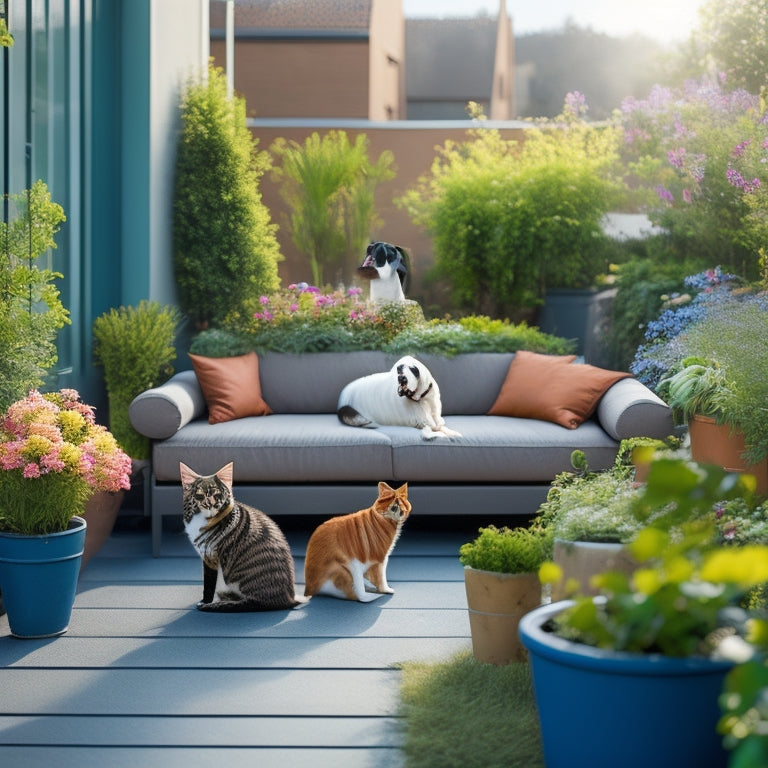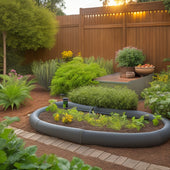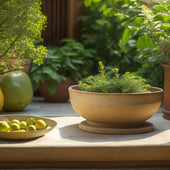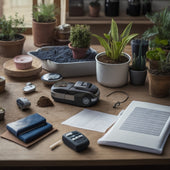
What to Know Before Starting a Pet-Friendly Rooftop Garden
Share
Before starting your pet-friendly rooftop garden, you'll want to assess your rooftop's structural integrity, check for signs of wear or damage, and identify areas receiving sufficient sunlight. Verify pet safety by identifying potential hazards, securing plants and decorations, and choosing non-toxic flowers and pet-friendly alternatives for fertilizers and pesticides. Consider weight capacity by selecting lightweight soil options and distributing weight evenly. Don't forget to prioritize waterproofing and drainage, provide shade and comfort for your pets, and establish ongoing maintenance routines. By considering these essential factors, you'll be well on your way to creating a thriving and safe outdoor space for you and your furry friends to enjoy - and there's more to explore to make it a perfect haven.
Key Takeaways
• Assess rooftop structural integrity to ensure it can support soil, plants, and pets before starting the garden.
• Identify potential hazards, toxic substances, and sharp objects to ensure pet safety in the rooftop garden.
• Choose non-toxic, pet-friendly plants, and research each species to confirm their safety for pets.
• Consider rooftop weight capacity, waterproofing, and drainage to prevent structural damage and erosion.
• Plan for ongoing maintenance, including pruning, watering, and pest management to keep the garden healthy and safe.
Assessing Your Rooftop's Potential
Before transforming your rooftop into a pet-friendly oasis, take stock of its current condition, considering factors like structural integrity, sunlight exposure, and wind direction to determine its potential for a thriving garden.
You want to guarantee your rooftop can support the weight of soil, plants, and, of course, your furry friends. Assess the rooftop's framework, checking for any signs of wear or damage that could compromise its stability.
Next, evaluate the sunlight exposure on your rooftop. Most plants require at least six hours of direct sunlight per day, so identify the areas that receive the most sunlight. You may need to adjust your garden layout accordingly.
Additionally, consider wind protection – a windy rooftop can be challenging for plants to thrive. You may need to incorporate windbreaks, such as trellises or screens, to create a more sheltered environment.
Pet Safety Considerations First
As you envision your pet-friendly rooftop oasis, your furry friend's safety should be top of mind, prompting you to contemplate the potential hazards that could harm them.
It's vital to prioritize pet safety considerations before bringing your pet into the rooftop garden. You'll want to guarantee that your pet can't access any hazardous materials, such as sharp objects, toxic substances, or electrical cords.
Pet toxicity awareness is also essential. Be aware of any substances that could harm your pet if ingested, such as fertilizers, pesticides, or certain plants. Keep these substances out of reach or opt for pet-friendly alternatives.
Additionally, consider your pet's behavior and personality traits. For example, if your pet is prone to digging, you'll want to secure any plants or fragile decorations.
Choosing Pet-Friendly Plants Only
You'll want to select plants that are non-toxic and safe for your furry friends to be around, guaranteeing that your pet-friendly rooftop garden is a haven rather than a hazard.
You can opt for non-toxic flowers like petunias, daisies, and marigolds, which aren't only beautiful but also safe for your pets to sniff around. Edible herbs like basil, mint, and parsley are also great options, allowing you to grow your own fresh herbs while keeping your pets safe.
When selecting plants, make certain to research each species to verify they're pet-friendly. Some plants, like succulents and cacti, may seem harmless but can still cause gastrointestinal issues if ingested.
You can also consider using planters with wide bases to prevent them from tipping over, and placing them out of reach from your pets. By choosing the right plants and taking necessary precautions, you can create a pet-friendly rooftop garden that's both beautiful and safe for your furry friends to enjoy.
Rooftop Garden Weight Capacity
Now that you've selected pet-friendly plants, it's vital to make certain your rooftop garden can support their weight, as well as your own, to avoid any structural damage or accidents. You don't want your dream garden to become a safety hazard.
To guarantee your rooftop garden is structurally sound, you'll need to take into account the weight capacity of your rooftop. This includes the weight of the soil, plants, and any hardscapes or features you plan to add.
Different soil types have varying weights, so it's important to choose a lightweight option. For example, a mix of peat moss and perlite can be a good choice as it's both lightweight and well-draining.
Additionally, think about the weight distribution of your plants and features. Avoid clustering heavy plants or features in one area, as this can put undue stress on your rooftop. Instead, distribute the weight evenly to make certain your rooftop garden is safe and secure.
Waterproofing and Drainage Essentials
Proper waterproofing and drainage are essential to prevent water from seeping into your building and causing damage. Make sure you choose a reliable waterproofing membrane and a well-designed drainage system for your pet-friendly rooftop garden. You don't want to risk structural issues or costly repairs down the line.
When selecting a waterproofing membrane, consider advanced waterproofing techniques like EPDM (ethylene propylene diene monomer) or PVC (polyvinyl chloride) membranes, which offer superior protection against water infiltration.
For drainage solutions, confirm your system is designed to handle heavy rainfall and snowmelt. A well-designed drainage system will direct water away from your building, preventing waterlogging and erosion.
Don't forget to include a drainage layer, such as a geotextile fabric, to filter debris and prevent clogs. By investing in a reliable waterproofing and drainage system, you'll create a safe and healthy environment for your pets to thrive in your rooftop garden.
Providing Shade and Comfort
With a reliable waterproofing and drainage system in place, you can focus on creating a comfortable oasis for your pets by incorporating shade-providing elements that will keep them cool and happy on warm days.
As a pet owner, you know how important it is to provide a comfortable environment for your furry friends. Shade structures such as gazebos, pergolas, or umbrellas can create a sense of security and relaxation for your pets. You can also consider installing shade sails or awnings to block direct sunlight.
Creating comfort zones is also essential in your pet-friendly rooftop garden. Consider adding plush pet beds or hammocks where your pets can lounge and relax. You can also incorporate calming elements like water features or wind chimes to create a soothing atmosphere.
Ongoing Maintenance Requirements
As you enjoy your pet-friendly rooftop garden, you'll need to set aside time each week to perform routine tasks that'll keep your outdoor space safe, clean, and healthy for your pets. This ongoing maintenance is vital to guarantee your pets can continue to thrive in their new environment.
Here are some essential tasks to include in your weekly routine:
-
Watering and pruning: Check soil moisture levels and adjust your watering schedule accordingly. Prune plants to maintain their shape and promote healthy growth.
-
Seasonal upkeep: Adapt your garden to changing seasons by switching out plants, adjusting fertilizers, and protecting sensitive plants from harsh weather conditions.
-
Pest management: Keep an eye out for signs of pests, such as aphids or whiteflies, and take action quickly to prevent infestations.
- Waste removal: Scoop up pet waste regularly to prevent the spread of disease and maintain a clean environment.
Frequently Asked Questions
Can I Grow Pet-Friendly Herbs in My Rooftop Garden?
You're probably wondering, "Can I grow pet-friendly herbs in my rooftop garden?" Think of it like hosting a dinner party - you want to serve safe, healthy options for your furry friends. Choose herbs like basil, mint, or parsley, ensuring plant safety with careful herb selection.
Are There Pet-Friendly Rooftop Garden Furniture Options?
You'll find pet-friendly rooftop garden furniture options that cater to your furry friends' needs, featuring eco-friendly materials and durable designs that withstand scratching and chewing, ensuring a safe and comfortable space for both you and your pets.
How Often Should I Clean My Pet-Friendly Rooftop Garden?
You'll want to establish a regular cleaning schedule for your pet-friendly rooftop garden to prevent pest control issues, so aim to tidy up weekly and deep clean monthly to keep your space safe and enjoyable for your furry friends.
What Are Some Pet-Friendly Rooftop Garden Themes to Consider?
You'll love exploring pet-friendly rooftop garden themes that prioritize plant selection and safety features, like a "Paw Playground" with pet-safe plants and sturdy fencing, or a "Whisker Wilderness" with hidden nooks and scratching posts.
Can I Host Pet-Friendly Events in My Rooftop Garden?
'You're dreaming of hosting pet-friendly events in your rooftop oasis, and why not? With careful event planning, you can guarantee pet safety while creating unforgettable experiences for your furry friends and their owners.'
Related Posts
-

Irrigation Solutions for Raised Bed Planters Made Easy
You can optimize your raised bed planters' irrigation system by understanding the complex interplay between soil type...
-

Irrigation Solutions for Raised Bed Planters Made Easy
You can optimize your raised bed planters' irrigation system by understanding the complex interplay between soil type...
-

Irrigation Solutions for Raised Bed Planters Made Easy
You can optimize your raised bed planters' irrigation system by understanding the complex interplay between soil type...
-

Irrigation Solutions for Raised Bed Planters Made Easy
You can optimize your raised bed planters' irrigation system by understanding the complex interplay between soil type...
-

Irrigation Solutions for Raised Bed Planters Made Easy
You can optimize your raised bed planters' irrigation system by understanding the complex interplay between soil type...
-

Irrigation Solutions for Raised Bed Planters Made Easy
You can optimize your raised bed planters' irrigation system by understanding the complex interplay between soil type...
-

Irrigation Solutions for Raised Bed Planters Made Easy
You can optimize your raised bed planters' irrigation system by understanding the complex interplay between soil type...
-

Irrigation Solutions for Raised Bed Planters Made Easy
You can optimize your raised bed planters' irrigation system by understanding the complex interplay between soil type...
-

Irrigation Solutions for Raised Bed Planters Made Easy
You can optimize your raised bed planters' irrigation system by understanding the complex interplay between soil type...
-

Irrigation Solutions for Raised Bed Planters Made Easy
You can optimize your raised bed planters' irrigation system by understanding the complex interplay between soil type...
-

Irrigation Solutions for Raised Bed Planters Made Easy
You can optimize your raised bed planters' irrigation system by understanding the complex interplay between soil type...
-

Irrigation Solutions for Raised Bed Planters Made Easy
You can optimize your raised bed planters' irrigation system by understanding the complex interplay between soil type...
-

Irrigation Solutions for Raised Bed Planters Made Easy
You can optimize your raised bed planters' irrigation system by understanding the complex interplay between soil type...
-

Irrigation Solutions for Raised Bed Planters Made Easy
You can optimize your raised bed planters' irrigation system by understanding the complex interplay between soil type...
-

Irrigation Solutions for Raised Bed Planters Made Easy
You can optimize your raised bed planters' irrigation system by understanding the complex interplay between soil type...
-

Irrigation Solutions for Raised Bed Planters Made Easy
You can optimize your raised bed planters' irrigation system by understanding the complex interplay between soil type...
-

Irrigation Solutions for Raised Bed Planters Made Easy
You can optimize your raised bed planters' irrigation system by understanding the complex interplay between soil type...
-

Irrigation Solutions for Raised Bed Planters Made Easy
You can optimize your raised bed planters' irrigation system by understanding the complex interplay between soil type...
-

Irrigation Solutions for Raised Bed Planters Made Easy
You can optimize your raised bed planters' irrigation system by understanding the complex interplay between soil type...
-

Irrigation Solutions for Raised Bed Planters Made Easy
You can optimize your raised bed planters' irrigation system by understanding the complex interplay between soil type...
-

Irrigation Solutions for Raised Bed Planters Made Easy
You can optimize your raised bed planters' irrigation system by understanding the complex interplay between soil type...
-

Irrigation Solutions for Raised Bed Planters Made Easy
You can optimize your raised bed planters' irrigation system by understanding the complex interplay between soil type...
-

Irrigation Solutions for Raised Bed Planters Made Easy
You can optimize your raised bed planters' irrigation system by understanding the complex interplay between soil type...
-

Irrigation Solutions for Raised Bed Planters Made Easy
You can optimize your raised bed planters' irrigation system by understanding the complex interplay between soil type...
-

Irrigation Solutions for Raised Bed Planters Made Easy
You can optimize your raised bed planters' irrigation system by understanding the complex interplay between soil type...
-

Irrigation Solutions for Raised Bed Planters Made Easy
You can optimize your raised bed planters' irrigation system by understanding the complex interplay between soil type...
-

Irrigation Solutions for Raised Bed Planters Made Easy
You can optimize your raised bed planters' irrigation system by understanding the complex interplay between soil type...
-

Irrigation Solutions for Raised Bed Planters Made Easy
You can optimize your raised bed planters' irrigation system by understanding the complex interplay between soil type...
-

10 Natural Ways to Clean Your Planters
You can transform your planters from grimy to gleaming with these 10 natural cleaning solutions. Mix baking soda and ...
-

10 Natural Ways to Clean Your Planters
You can transform your planters from grimy to gleaming with these 10 natural cleaning solutions. Mix baking soda and ...
-

10 Natural Ways to Clean Your Planters
You can transform your planters from grimy to gleaming with these 10 natural cleaning solutions. Mix baking soda and ...
-

10 Natural Ways to Clean Your Planters
You can transform your planters from grimy to gleaming with these 10 natural cleaning solutions. Mix baking soda and ...
-

10 Natural Ways to Clean Your Planters
You can transform your planters from grimy to gleaming with these 10 natural cleaning solutions. Mix baking soda and ...
-

10 Natural Ways to Clean Your Planters
You can transform your planters from grimy to gleaming with these 10 natural cleaning solutions. Mix baking soda and ...
-

10 Natural Ways to Clean Your Planters
You can transform your planters from grimy to gleaming with these 10 natural cleaning solutions. Mix baking soda and ...
-

10 Natural Ways to Clean Your Planters
You can transform your planters from grimy to gleaming with these 10 natural cleaning solutions. Mix baking soda and ...
-

10 Natural Ways to Clean Your Planters
You can transform your planters from grimy to gleaming with these 10 natural cleaning solutions. Mix baking soda and ...
-

10 Natural Ways to Clean Your Planters
You can transform your planters from grimy to gleaming with these 10 natural cleaning solutions. Mix baking soda and ...
-

10 Natural Ways to Clean Your Planters
You can transform your planters from grimy to gleaming with these 10 natural cleaning solutions. Mix baking soda and ...
-

10 Natural Ways to Clean Your Planters
You can transform your planters from grimy to gleaming with these 10 natural cleaning solutions. Mix baking soda and ...
-

10 Natural Ways to Clean Your Planters
You can transform your planters from grimy to gleaming with these 10 natural cleaning solutions. Mix baking soda and ...
-

10 Natural Ways to Clean Your Planters
You can transform your planters from grimy to gleaming with these 10 natural cleaning solutions. Mix baking soda and ...
-

10 Natural Ways to Clean Your Planters
You can transform your planters from grimy to gleaming with these 10 natural cleaning solutions. Mix baking soda and ...
-

10 Natural Ways to Clean Your Planters
You can transform your planters from grimy to gleaming with these 10 natural cleaning solutions. Mix baking soda and ...
-

10 Natural Ways to Clean Your Planters
You can transform your planters from grimy to gleaming with these 10 natural cleaning solutions. Mix baking soda and ...
-

10 Natural Ways to Clean Your Planters
You can transform your planters from grimy to gleaming with these 10 natural cleaning solutions. Mix baking soda and ...
-

10 Natural Ways to Clean Your Planters
You can transform your planters from grimy to gleaming with these 10 natural cleaning solutions. Mix baking soda and ...
-

10 Natural Ways to Clean Your Planters
You can transform your planters from grimy to gleaming with these 10 natural cleaning solutions. Mix baking soda and ...
-

10 Natural Ways to Clean Your Planters
You can transform your planters from grimy to gleaming with these 10 natural cleaning solutions. Mix baking soda and ...
-

10 Natural Ways to Clean Your Planters
You can transform your planters from grimy to gleaming with these 10 natural cleaning solutions. Mix baking soda and ...
-

10 Natural Ways to Clean Your Planters
You can transform your planters from grimy to gleaming with these 10 natural cleaning solutions. Mix baking soda and ...
-

10 Natural Ways to Clean Your Planters
You can transform your planters from grimy to gleaming with these 10 natural cleaning solutions. Mix baking soda and ...
-

10 Natural Ways to Clean Your Planters
You can transform your planters from grimy to gleaming with these 10 natural cleaning solutions. Mix baking soda and ...
-

10 Natural Ways to Clean Your Planters
You can transform your planters from grimy to gleaming with these 10 natural cleaning solutions. Mix baking soda and ...
-

10 Natural Ways to Clean Your Planters
You can transform your planters from grimy to gleaming with these 10 natural cleaning solutions. Mix baking soda and ...
-

10 Natural Ways to Clean Your Planters
You can transform your planters from grimy to gleaming with these 10 natural cleaning solutions. Mix baking soda and ...
-

10 Natural Ways to Clean Your Planters
You can transform your planters from grimy to gleaming with these 10 natural cleaning solutions. Mix baking soda and ...
-

10 Natural Ways to Clean Your Planters
You can transform your planters from grimy to gleaming with these 10 natural cleaning solutions. Mix baking soda and ...
-

10 Natural Ways to Clean Your Planters
You can transform your planters from grimy to gleaming with these 10 natural cleaning solutions. Mix baking soda and ...
-

10 Natural Ways to Clean Your Planters
You can transform your planters from grimy to gleaming with these 10 natural cleaning solutions. Mix baking soda and ...
-

10 Natural Ways to Clean Your Planters
You can transform your planters from grimy to gleaming with these 10 natural cleaning solutions. Mix baking soda and ...
-

10 Natural Ways to Clean Your Planters
You can transform your planters from grimy to gleaming with these 10 natural cleaning solutions. Mix baking soda and ...
-

10 Natural Ways to Clean Your Planters
You can transform your planters from grimy to gleaming with these 10 natural cleaning solutions. Mix baking soda and ...
-

Accurate Measuring for DIY Block Planters Made Easy
As you begin building a DIY block planter, precise measurement is essential for a sturdy structure that can support s...
-

Accurate Measuring for DIY Block Planters Made Easy
As you begin building a DIY block planter, precise measurement is essential for a sturdy structure that can support s...
-

Accurate Measuring for DIY Block Planters Made Easy
As you begin building a DIY block planter, precise measurement is essential for a sturdy structure that can support s...
-

Accurate Measuring for DIY Block Planters Made Easy
As you begin building a DIY block planter, precise measurement is essential for a sturdy structure that can support s...
-

Accurate Measuring for DIY Block Planters Made Easy
As you begin building a DIY block planter, precise measurement is essential for a sturdy structure that can support s...
-

Accurate Measuring for DIY Block Planters Made Easy
As you begin building a DIY block planter, precise measurement is essential for a sturdy structure that can support s...
-

Accurate Measuring for DIY Block Planters Made Easy
As you begin building a DIY block planter, precise measurement is essential for a sturdy structure that can support s...
-

Accurate Measuring for DIY Block Planters Made Easy
As you begin building a DIY block planter, precise measurement is essential for a sturdy structure that can support s...
-

Accurate Measuring for DIY Block Planters Made Easy
As you begin building a DIY block planter, precise measurement is essential for a sturdy structure that can support s...
-

Accurate Measuring for DIY Block Planters Made Easy
As you begin building a DIY block planter, precise measurement is essential for a sturdy structure that can support s...
-

Accurate Measuring for DIY Block Planters Made Easy
As you begin building a DIY block planter, precise measurement is essential for a sturdy structure that can support s...
-

Accurate Measuring for DIY Block Planters Made Easy
As you begin building a DIY block planter, precise measurement is essential for a sturdy structure that can support s...
-

Accurate Measuring for DIY Block Planters Made Easy
As you begin building a DIY block planter, precise measurement is essential for a sturdy structure that can support s...
-

Accurate Measuring for DIY Block Planters Made Easy
As you begin building a DIY block planter, precise measurement is essential for a sturdy structure that can support s...
-

Accurate Measuring for DIY Block Planters Made Easy
As you begin building a DIY block planter, precise measurement is essential for a sturdy structure that can support s...
-

Accurate Measuring for DIY Block Planters Made Easy
As you begin building a DIY block planter, precise measurement is essential for a sturdy structure that can support s...
-

Accurate Measuring for DIY Block Planters Made Easy
As you begin building a DIY block planter, precise measurement is essential for a sturdy structure that can support s...
-

Accurate Measuring for DIY Block Planters Made Easy
As you begin building a DIY block planter, precise measurement is essential for a sturdy structure that can support s...
-

Accurate Measuring for DIY Block Planters Made Easy
As you begin building a DIY block planter, precise measurement is essential for a sturdy structure that can support s...
-

Accurate Measuring for DIY Block Planters Made Easy
As you begin building a DIY block planter, precise measurement is essential for a sturdy structure that can support s...
-

Accurate Measuring for DIY Block Planters Made Easy
As you begin building a DIY block planter, precise measurement is essential for a sturdy structure that can support s...
-

Accurate Measuring for DIY Block Planters Made Easy
As you begin building a DIY block planter, precise measurement is essential for a sturdy structure that can support s...
-

Accurate Measuring for DIY Block Planters Made Easy
As you begin building a DIY block planter, precise measurement is essential for a sturdy structure that can support s...
-

Accurate Measuring for DIY Block Planters Made Easy
As you begin building a DIY block planter, precise measurement is essential for a sturdy structure that can support s...
-

Accurate Measuring for DIY Block Planters Made Easy
As you begin building a DIY block planter, precise measurement is essential for a sturdy structure that can support s...
-

Accurate Measuring for DIY Block Planters Made Easy
As you begin building a DIY block planter, precise measurement is essential for a sturdy structure that can support s...
-

Accurate Measuring for DIY Block Planters Made Easy
As you begin building a DIY block planter, precise measurement is essential for a sturdy structure that can support s...


